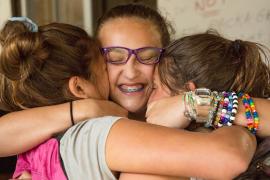This article is meant to complement the March 2019 CampLine article on the legal obligations surrounding service animals at camp, “Service Animals at Camp. Yes. And. But.” by Catherine Hansen-Stamp and Charles R. Gregg. Please refer to that article first before reading this one.
So, you have decided to host a service animal at camp. Now what? This article is meant to demystify the hands-on, day-to-day aspects of hosting a service animal, specifically a service dog, during a camp session. This refers only to service dogs, not emotional support animals. These are working dogs that are necessary for the camper’s health and perform a specific function in their medical well-being.
I. Preparation, Preparation, Preparation
As with anything at camp, preparation is the key to success in hosting a camper or family that utilizes a service dog. Think about your campsite, your staff, and your other participants (campers and families). Tackling this holistically will only help make the session run smoother for everyone involved, including the service dog.
First, develop a policy and forms to collect information about the service dog and the camper’s use of the dog. Think of this as a camper application for another kind of camper — a much furrier camper. In this form and your policy, spell out the information you will need about the dog to make the camper and the dog successful, namely:
- Clarification of the dog’s role with the camper. What is the dog responsible for? This will help guide you as to where the dog needs to be when. The dog is working, so what is its function? Does it detect seizures? Help the camper navigate the environment? Etc.
- Information about the dog’s temperament. Most service dogs are very well-mannered, which is a large part of the reason they have been chosen to be service animals. However, some service dogs are much more protective of their owners than others, and this is something you will want to know.
- When does the dog need to be with the camper? At all times? At the horse barn (you will need to prepare the horses then)? At the ropes course?
- Can the dog be unsupervised?
- Can the camper take care of the dog’s needs (feeding, cleaning up after the dog, etc.)? If not, you need to factor this into your staffing for the session. It is also a good idea to provide the participants with a map of where the dog can relieve itself and where to dispose of the waste. This is easy and inclusive.
- Introduction and interactions with the dog. How would the family/camper like their dog introduced to the camp community? Can others pet the dog? If so, when can they pet the dog? This is important: often others are asked not to pet service dogs because they are “on duty,” performing the function they are trained to do, and should not be distracted.
- Vaccination information. Collect the dog’s vaccination records just like you would for a camper/family attending camp.
Have your program and medical staff review this form before the dog arrives at camp so that everyone is prepared with the information and can do any necessary follow-up before arrival day.
Next, a dog in camp is probably not the norm, so you need to prepare the rest of the camp community. The goal should be that the camper is not answering questions about their service animal. The use of a service dog can make a child feel “othered,” so adults should aim to field questions, and preparing beforehand is the best way to head off any misdirected inquiries.
Staff training, staff meetings, and opening campfire are good times to introduce information about the service dog and the camper’s use of the dog to the camp community. Information to share includes:
- Information everyone needs to know to make the camper successful.
- Explain what task or tasks the dog is trained to do. This way, everyone understands the dog’s job.
- Detail how your staff and other participants are expected to interact with the dog.
- Check with other participants about their feelings toward dogs. Is anyone afraid or allergic? If so, you will want to house these participants separate from the camper with the dog. If allergies are an issue, you may also want to put some air purifiers in the cabins/dining hall/other closed activity areas for the session to help alleviate this.
II. Day in the Life
Your site is ready, you have collected information on the service dog, you have prepared others in the camp community, and you are ready for arrival day. Now what? Because you have spent so much time on preparation, welcoming the service dog should go smoothly. A good idea is to assign a staff member who will be with the camper and the dog for the session, and who will meet the family on arrival. That way, any important information can be relayed right to the person who will oversee the dog for the session, and nothing will be lost. All questions should be asked at this point as well, including if any information on the dog or the camper’s use of the dog has changed since the application process.
Some thoughts to keep in mind during the camp session:
- Service dogs should not be allowed to go anywhere at camp that campers are not allowed. As the dog will always need to be with the camper, it should be an expectation that the dog is restricted to where the camper can go, even when it is relieving itself.
- The service dog should not be allowed to go into other cabins or sleeping areas that are not assigned to the camper. You will have collected information on allergies and dog aversions and assigned camper cabins accordingly; respect this as much as possible.
- Dogs should not be allowed in the kitchen. Fairly self-explanatory, but most health departments would not be too keen on an animal in the kitchen.
- If possible, seating the camper or family near the exit door in the dining hall is a good idea. The dog is out of the way when trays of food are being brought out and proximity to the exit provides easy access to outside if the dog needs to use the lawn.
III. Follow-Up
The session was a success! The camper and the service dog seemed to have a great time, and the rest of the camp community was happy with the execution as well. You should still follow-up with your staff and the camper’s family afterward to get input for improvement for next time you host a service dog. This should be done soon after the session ends so information is fresh in everyone’s minds and recorded for future use.
This process will not be perfect the first time you attempt it, and that is OK. You will learn from the challenges to be even better for the next camper, just like anything new tackled at camp. The important thing is that you can include a camper who needs camp, which is the greatest thing we can do in our work.
The information presented is a cumulation of best practices from SeriousFun Children’s Network camps. Every camp will need to evaluate for themselves what works, and not everything suggested will work for every camp. The author is open to further discussions on the topic to share her knowledge and learn from others.
Samantha Clark has held many roles in the camp community since 2006. She currently works on the program team at SeriousFun Children’s Network, supporting the 30 camps and programs around the world in their pursuit to provide life-changing experiences for kids and families living with serious illnesses. Please reach her at samantha.clark@seriousfunnetwork.org.



